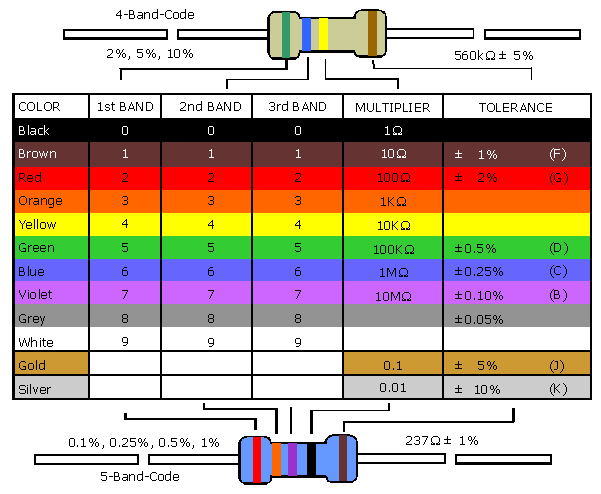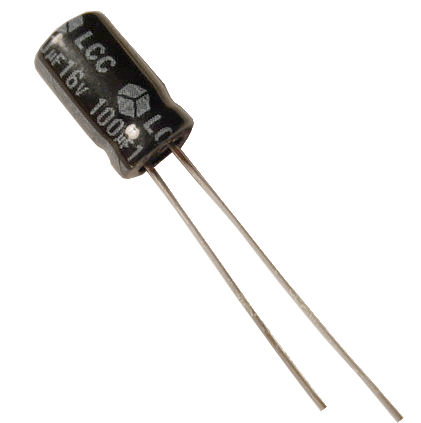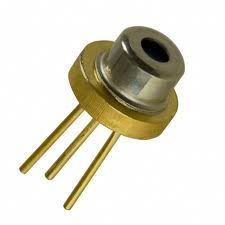alf638
0
- Joined
- Dec 10, 2010
- Messages
- 218
- Points
- 0
When I first joined this forum I had no electrical experience and I found the whole concept of electricity very confusing. I am writing this guide to help people who may be having the same problem.
Firstly, electricity is measured in volts and amps. One milivolt is 1/1000th of a volt and likewise a milliamp (the most common unit used in this hobby), is 1/1000th of an amp.
Volts are abbreviated as V and millivolts are known as mV. Amps are abbeviated as A and milliamps are mA amps are also known as current.
Electricity itself is a flow of particles called electrons.
Here is an analogy to describe it (this particular analogy was suggested by Anslem). Think of Electricity as a water pipe or tap if you like.
Current (amps) is like the diameter of the pipe, and tension (volts) is like
the pressure (or speed of flow) of the water.
Power (Watt) is like the total amount of water that comes out of the tap.
Electrons are always emmited from the negative of a power source, but it is equally important to have the positive connected as this provides a return path for the electrons.
However, it is not this simple. Laser diodes cannot just be connected to a battery and then work as batteries (and almost every othe power supply), produces spikes of high current and/or high voltage which can kill a laser diode. To combat this you must buy or build a constant current laser driver. More details on this can be found in the link at the bottom of this page.
SOLDERING: To connect electronic components you must solder them. This means using a soldering iron to heat solder unil it melts and then applying it to the components. This is quite simple with most components, but laser diodes are the exeption. To much heat can kill them so you should never leave the soldering iron on them for more than about three seconds.
For a full guide to soldering, see the links at the bottom of the page.
BASIC ELECTRONIC COMPONENTS: As I am sure you know their are many types of electonic components, resistors, capacitors, transistors, regulators and many others. In this section I will try to provide a basic description of some of these components and how they can be used in lasers.
RESISTORS: The opposite of current (amps), is resistance. Resistors, when a voltage is applied across their terminal provide a drop in current that is proportional to the voltage applied. This current drop can be worked out using ohms law which I will detail in a later section.
The resistance of a resistor is measured in Ohms, Kilohms and Megaohms A Kilohm (abreviated Kohm), is 1,000 Ohms and a Megaohm is 1,000,000 Ohms.
In laser use, resistors are usually used to limit the current sent to a laser diode.
In circuit diagrams this is the symbol for a resistor.

The resistance of a resistor can be worked out using a DMM (digital multimeter), but is normally worked out using a table that refers to the colour bands on a resistor.
This is a copy of that table.

CAPACITORS: Capacitors are devices used for storing electric charge, in laser use they are usually used to absorb voltage spikes from batteries.
Capacitors are measured in volts (V), and farads (F), usually capacitors are only in the order of mircrofarads (uf), or nanofarads (nf), it is very rare for a capacitor to be in the farad range. Volts in this context refer to the amount of voltage a capacitor can hold and farads refer to the capacitance of a capacitor. The capacitance refers to the area inside a capacitor in which the electric charge is stored.
The lower capacitance a capacitor has, the quicker it will charge to full power. When a capacitor reaches full power it will discharge and release all of it's stored electricity.
Capacitors are typically made up of three layers; two thin metal plates in which electricity is stored and a dielectric layer which seperates the two metal plates.
This is the symbol used for capacitors in electronic circuits:

This is a diagram of a capacitor:

A typical capacitor:

LASER DIODES: Laser diodes run of between 2V(for infrared diodes), and 4.5V(for blue/purple diodes.) There is a huge range of different currents at which laser diodes can run, everywhere from a few mA for low powered (<1mw), diodes to hundreds of amps for huge laser diode arrays.
As a guide, 405nm (violet), diodes have two main types. The phr diode which can run on upto 120mA for about 100mW of output power and the 12X diode which has been ran at over 700mA for outputs of over 800mW.
Some blue (445nm), diodes known as A-140 or A-130 diodes can be ran at over 1.8A (1800mA) for powers exceding 2000mW.
Green lasers do not come in diode form, only in the form of modules which use the DPSS (diode pumped solid state), process to change an infrared diodes beam into a visible green one. There is no set power at which to run these modules as they usually have drivers built in. So refer to the spec sheet for your own module to find the input power.
Red diodes are most comonnly LOC (long open can), diodes and can be ran at 400mA for around 300mW of output power.
This is by no means a full list of laser diodes, or a full guide on the DPSS proccess so for more imformation on these topics I have compiled several links at the bottom of this page.
Laser diodes come in many different sizes, the most common size being known as to-18. These are also known as 5.6mm diodes. They resemble a small metal transistor with awindow in the top. The colour light a laser diode will emit can be tested by looking at this glass window and noting the colour the reflection appears.
Red lasers will have a blue coating, IR diodes will be yellow to green and blu-ray and 445nm diodes will be a yellow orange coulor.
I could write all day on exactly how these work, put it would be very long and boring so I will just some links at the bottom of the page .
.
A standard to-18 diode. Some of these can output upto 2W

A c-mount diode. These normally output upto 5 W

A bar diode. Some of these can put out over 100W!

This was my first attempt at a guide like this and I hope it will be useful to at least a few people who are, like I was having a hard time with the basic concept of electricity. If I have got anything wrong or left anything out, just let me know and I will edit and add it.
Remember this hobby deals with high powered lasers (obviously), and so laser safety glasses are a must for any lasers over 5mW
So, enjoy the hobby, stay safe and have fun.
FURTHER READING ON THIS AN OTHER SUBJECTS:
Here is the promised links, I hope you enjoy them and find them useful.
DPSS and general lasers.
Soldering laser diodes.
General soldering.
Laser diodes inner workings.
DPSS basics.
Diode compilation.
Laser driver basics.
Just about everything you will ever need to know about lasers.
A good guide to building your first laser.
Firstly, electricity is measured in volts and amps. One milivolt is 1/1000th of a volt and likewise a milliamp (the most common unit used in this hobby), is 1/1000th of an amp.
Volts are abbreviated as V and millivolts are known as mV. Amps are abbeviated as A and milliamps are mA amps are also known as current.
Electricity itself is a flow of particles called electrons.
Here is an analogy to describe it (this particular analogy was suggested by Anslem). Think of Electricity as a water pipe or tap if you like.
Current (amps) is like the diameter of the pipe, and tension (volts) is like
the pressure (or speed of flow) of the water.
Power (Watt) is like the total amount of water that comes out of the tap.
Electrons are always emmited from the negative of a power source, but it is equally important to have the positive connected as this provides a return path for the electrons.
However, it is not this simple. Laser diodes cannot just be connected to a battery and then work as batteries (and almost every othe power supply), produces spikes of high current and/or high voltage which can kill a laser diode. To combat this you must buy or build a constant current laser driver. More details on this can be found in the link at the bottom of this page.
SOLDERING: To connect electronic components you must solder them. This means using a soldering iron to heat solder unil it melts and then applying it to the components. This is quite simple with most components, but laser diodes are the exeption. To much heat can kill them so you should never leave the soldering iron on them for more than about three seconds.
For a full guide to soldering, see the links at the bottom of the page.
BASIC ELECTRONIC COMPONENTS: As I am sure you know their are many types of electonic components, resistors, capacitors, transistors, regulators and many others. In this section I will try to provide a basic description of some of these components and how they can be used in lasers.
RESISTORS: The opposite of current (amps), is resistance. Resistors, when a voltage is applied across their terminal provide a drop in current that is proportional to the voltage applied. This current drop can be worked out using ohms law which I will detail in a later section.
The resistance of a resistor is measured in Ohms, Kilohms and Megaohms A Kilohm (abreviated Kohm), is 1,000 Ohms and a Megaohm is 1,000,000 Ohms.
In laser use, resistors are usually used to limit the current sent to a laser diode.
In circuit diagrams this is the symbol for a resistor.

The resistance of a resistor can be worked out using a DMM (digital multimeter), but is normally worked out using a table that refers to the colour bands on a resistor.
This is a copy of that table.

CAPACITORS: Capacitors are devices used for storing electric charge, in laser use they are usually used to absorb voltage spikes from batteries.
Capacitors are measured in volts (V), and farads (F), usually capacitors are only in the order of mircrofarads (uf), or nanofarads (nf), it is very rare for a capacitor to be in the farad range. Volts in this context refer to the amount of voltage a capacitor can hold and farads refer to the capacitance of a capacitor. The capacitance refers to the area inside a capacitor in which the electric charge is stored.
The lower capacitance a capacitor has, the quicker it will charge to full power. When a capacitor reaches full power it will discharge and release all of it's stored electricity.
Capacitors are typically made up of three layers; two thin metal plates in which electricity is stored and a dielectric layer which seperates the two metal plates.
This is the symbol used for capacitors in electronic circuits:

This is a diagram of a capacitor:

A typical capacitor:

LASER DIODES: Laser diodes run of between 2V(for infrared diodes), and 4.5V(for blue/purple diodes.) There is a huge range of different currents at which laser diodes can run, everywhere from a few mA for low powered (<1mw), diodes to hundreds of amps for huge laser diode arrays.
As a guide, 405nm (violet), diodes have two main types. The phr diode which can run on upto 120mA for about 100mW of output power and the 12X diode which has been ran at over 700mA for outputs of over 800mW.
Some blue (445nm), diodes known as A-140 or A-130 diodes can be ran at over 1.8A (1800mA) for powers exceding 2000mW.
Green lasers do not come in diode form, only in the form of modules which use the DPSS (diode pumped solid state), process to change an infrared diodes beam into a visible green one. There is no set power at which to run these modules as they usually have drivers built in. So refer to the spec sheet for your own module to find the input power.
Red diodes are most comonnly LOC (long open can), diodes and can be ran at 400mA for around 300mW of output power.
This is by no means a full list of laser diodes, or a full guide on the DPSS proccess so for more imformation on these topics I have compiled several links at the bottom of this page.
Laser diodes come in many different sizes, the most common size being known as to-18. These are also known as 5.6mm diodes. They resemble a small metal transistor with awindow in the top. The colour light a laser diode will emit can be tested by looking at this glass window and noting the colour the reflection appears.
Red lasers will have a blue coating, IR diodes will be yellow to green and blu-ray and 445nm diodes will be a yellow orange coulor.
I could write all day on exactly how these work, put it would be very long and boring so I will just some links at the bottom of the page
A standard to-18 diode. Some of these can output upto 2W

A c-mount diode. These normally output upto 5 W

A bar diode. Some of these can put out over 100W!

This was my first attempt at a guide like this and I hope it will be useful to at least a few people who are, like I was having a hard time with the basic concept of electricity. If I have got anything wrong or left anything out, just let me know and I will edit and add it.
Remember this hobby deals with high powered lasers (obviously), and so laser safety glasses are a must for any lasers over 5mW
So, enjoy the hobby, stay safe and have fun.
FURTHER READING ON THIS AN OTHER SUBJECTS:
Here is the promised links, I hope you enjoy them and find them useful.
DPSS and general lasers.
Soldering laser diodes.
General soldering.
Laser diodes inner workings.
DPSS basics.
Diode compilation.
Laser driver basics.
Just about everything you will ever need to know about lasers.
A good guide to building your first laser.
Last edited:



